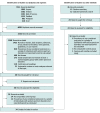Association Between Autism Spectrum Disorders and Cardiometabolic Diseases: A Systematic Review and Meta-analysis
- PMID: 36716018
- PMCID: PMC9887535
- DOI: 10.1001/jamapediatrics.2022.5629
Association Between Autism Spectrum Disorders and Cardiometabolic Diseases: A Systematic Review and Meta-analysis
Abstract
Importance: Although the increased risk of obesity among individuals with autism has been well established, evidence on the association between autism, cardiometabolic disorders, and obesity remains inconclusive.
Objective: To examine the association between autism spectrum disorders and cardiometabolic diseases in a systematic review and meta-analysis.
Data sources: PubMed, Scopus, Web of Science, ProQuest, Embase, and Ovid databases were searched from inception through July 31, 2022, without restrictions on date of publication or language.
Study selection: Observational or baseline data of interventional studies reporting the prevalence of cardiometabolic risk factors (ie, diabetes, hypertension, dyslipidemia, atherosclerotic macrovascular disease) among children and/or adults with autism and matched with participants without autism were included.
Data extraction and synthesis: Screening, data extraction, and quality assessment were performed independently by at least 2 researchers. DerSimonian-Laird random-effects meta-analyses were performed using the meta package in R.
Main outcomes and measures: Relative risks (RRs) of diabetes, hypertension, dyslipidemia, and atherosclerotic macrovascular disease among individuals with autism were the primary outcomes. Secondary outcomes included the RR of type 1 and type 2 diabetes, heart disease, stroke, and peripheral vascular disease.
Results: A total of 34 studies were evaluated and included 276 173 participants with autism and 7 733 306 participants without autism (mean [range] age, 31.2 [3.8-72.8] years; pooled proportion [range] of female individuals, 47% [0-66%]). Autism was associated with greater risks of developing diabetes overall (RR, 1.57; 95% CI, 1.23-2.01; 20 studies), type 1 diabetes (RR, 1.64; 95% CI, 1.06-2.54; 6 studies), and type 2 diabetes (RR, 2.47; 95% CI, 1.30-4.70; 3 studies). Autism was also associated with increased risks of dyslipidemia (RR, 1.69; 95% CI, 1.20-2.40; 7 studies) and heart disease (RR, 1.46; 95% CI, 1.42-1.50; 3 studies). Yet, there was no significantly associated increased risk of hypertension and stroke with autism (RR, 1.22; 95% CI, 0.98-1.52; 12 studies; and RR, 1.19; 95% CI, 0.63-2.24; 4 studies, respectively). Meta-regression analyses revealed that children with autism were at a greater associated risk of developing diabetes and hypertension compared with adults. High between-study heterogeneity was a concern for several meta-analyses.
Conclusions and relevance: Results suggest that the associated increased risk of cardiometabolic diseases should prompt clinicians to vigilantly monitor individuals with autism for potential contributors, signs of cardiometabolic disease, and their complications.
Conflict of interest statement
Figures





Comment in
-
Autism, Physical Health Conditions, and a Need for Reform.JAMA Pediatr. 2023 Mar 1;177(3):229-230. doi: 10.1001/jamapediatrics.2022.5639. JAMA Pediatr. 2023. PMID: 36716011 No abstract available.
-
Considerations Regarding Autism Spectrum Disorders and Cardiometabolic Diseases.JAMA Pediatr. 2023 Jul 1;177(7):737. doi: 10.1001/jamapediatrics.2023.1022. JAMA Pediatr. 2023. PMID: 37155162 No abstract available.
-
Considerations Regarding Autism Spectrum Disorders and Cardiometabolic Diseases-Reply.JAMA Pediatr. 2023 Jul 1;177(7):737-738. doi: 10.1001/jamapediatrics.2023.1025. JAMA Pediatr. 2023. PMID: 37155186 No abstract available.
References
-
- American Psychiatric Association . Diagnostic and Statistical Manual of Mental Disorders, 5th Edition: DSM-5. American Psychiatric Association; 2013.
-
- Maenner MJ, Shaw KA, Bakian AV, et al. . Prevalence and characteristics of autism spectrum disorder among children aged 8 years—autism and developmental disabilities monitoring network, 11 sites, United States, 2018. MMWR Surveill Summ. 2021;70(11):1-16. doi:10.15585/mmwr.ss7011a1 - DOI - PMC - PubMed

